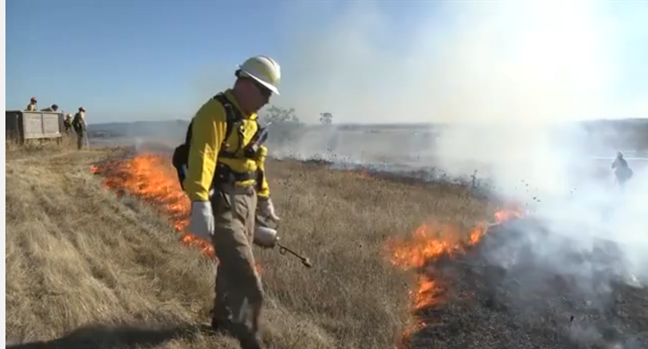Fire Prevention

Fire needs three elements to occur: fuel, oxygen and heat. Remove any one of them and the fire will die out. Fuel is defined as anything that can burn. Many fires start from a single ember that lands on a fuel source. The reduction of fuel sources around a structure can greatly increase the chance that it will survive a wildfire. Benton County or the Oregon Department of Forestry will provide a free home site evaluation of defensible space upon request, as well as trainings for groups.
The Importance of Fire
Fire is mostly seen as a destructive phenomenon, but it is actually a beneficial part of a healthy forest ecosystem. Fire helps remove unwanted invasive species, parasites, diseases and insects, while the remaining ash provides needed nutrients to the soil. Some trees require the fire’s high temperature to open their cones for seed dispersal and reproduction. Fire also helps reduce the amount of fuel in the forest, which means smaller, less severe wildfires.
Fire Protection Districts
Regardless of where you live, if you have a fire emergency, call 911. If you live outside city limits in Benton County, you are served by a Rural Fire Protection District. For nonemergency communication, such as backyard
burn advisories, contact your local fire district. If you aren’t sure which district you are in, consult your property tax statement. A list of fire districts is linked at the bottom of this page.

Defensible Space
Also called the Home Ignition Zone, this is an area where vegetation and fire fuels have been modified to reduce or stop fire spread and save homes and lives. Defensible space provides an opportunity for firefighters to effectively defend the building. Defensible space includes the home itself and everything around it up to 100-200 feet away and is comprised of these three sub-zones:
- Zone 1: 30 feet adjacent to the home and its attachments. This zone should be well irrigated and fire-resistant.
- Zone 2: 30 to 100 feet from the home. Plants in this zone should be low-growing, well irrigated and less flammable.
- Zone 3: 100-200 feet from the home. Thin this area, and remove heavy accumulation of woody debris.
Firewise Landscaping
Avoid resinous plants and trees such as pines (Pinus spp.), firs (Abies spp.), junipers (Juniperus spp.), and spruces (Picea spp.). Turfgrass, some species of ornamental grasses, evergreens, and deciduous shrubs are all good choices. Pathways, rock walls, and hardscape features also provide firebreaks in case a fire does break out. Dry stream beds and streams for water features are also beautiful and can provide nonflammable surfaces.
Here in the Northwest, some favorite fire-resistant plants are native manzanita (Arctostaphylos manzanita) which is actually fire dependent, meaning that it needs to go through fire to regenerate. Another great pick is fireweed (Chamerion angustifolium), which is an evergreen, purple-flowering perennial that has beautiful foliage, bark, and tiny flowers. A third pick is native bear grass (Xerophyllum tenax), which has a great root system that is very fire resistant. It’s also an evergreen that produces masses of white flowers.



